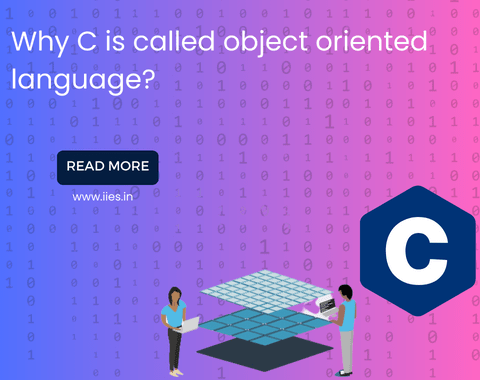Historical context of C language
C programming language was developed in the early 1970s by Dennis Ritchie at Bell Labs. It gained popularity due to its simplicity, efficiency, and low-level system access.
Features of C that align with OOP
Structs as user-defined types:
- C provides the struct keyword to define user-defined data structures.
- Structs can encapsulate data attributes, mimicking the class concept of OOP.
Function pointers and polymorphism:
- C allows the usage of function pointers, enabling polymorphic behaviors.
- Function pointers can be used to implement runtime method binding, similar to polymorphism in OOP.
Encapsulation through function interfaces:
- C uses function interfaces to encapsulate data and implementation details.
- By exposing only necessary functions, C can achieve a level of encapsulation similar to OOP languages.
Differences between C and traditional OOP languages
Lack of native class support:
- Unlike traditional OOP languages like Java or C++, C does not provide native support for classes and objects.
- Developers need to emulate class-like behavior using structs and functions.
Limited encapsulation compared to modern OOP languages:
- C’s approach to encapsulation is more manual and less strict compared to modern OOP languages.
- Developers must ensure proper design and discipline to achieve encapsulation.
Case Studies: Object-Oriented Concepts in C
Case study 1: Simulating classes with structs
Creating a struct as a class equivalent:
- Developers can define structs to encapsulate related data and behaviors.
- Structs can be used to represent objects similar to classes in OOP.
Defining methods as functions operating on structs:
- By implementing functions that operate on structs, developers can emulate methods associated with objects.
- These functions can manipulate the data within the structs.
Case study 2: Achieving polymorphism with function pointers
Explaining function pointers:
- The concept of function pointers allows the storing and passing of function addresses.
- Function pointers enable polymorphic behavior by choosing appropriate functions at runtime.
Implementing polymorphic behavior in C:
- By utilizing function pointers, C code can achieve polymorphism.
- Function pointers can be used to invoke different behaviors based on the type of object.
Case study 3: Encapsulation using function interfaces
Creating interfaces to hide implementation details:
- C can simulate encapsulation by exposing only relevant functions through interfaces.
- The interface hides internal implementation details, providing a clean and consistent way to interact with objects.
Illustrating data hiding through interfaces:
- By exposing only the necessary functions through the interface, C can achieve data hiding.
- External code cannot directly access or modify internal object representation.
Challenges and Limitations
Drawbacks of using C for OOP
Manual memory management:
- In C, developers must manage memory allocation and deallocation manually.
- This can lead to memory leaks and other memory-related issues if not handled properly.
Lack of language-level support for inheritance:
- Unlike modern OOP languages, C does not provide native support for inheritance.
- Developers need to implement inheritance-like behavior manually.
Workarounds and best practices
Memory management techniques:
- Developers can use careful memory allocation and deallocation practices, such as tracking allocation and proper deallocation of resources.
Design patterns for mimicking inheritance:
- Various design patterns can be utilized to mimic inheritance in C, such as composition and function pointers.
Modern Extensions: C++ and Beyond
Introduction to C++
C++ is an extension of the C programming language and is considered a multi-paradigm language. It natively supports object oriented language, among other paradigms.
Evolution from C to C++
C++ evolved from C and introduced additional features, including classes, objects, and better support for OOP principles. It retained C’s efficiency and low-level access while enhancing capabilities.
Enhanced OOP features in C++
Native class and object support:
- C++ introduced the class keyword to natively define classes and objects.
- This makes it easier and more intuitive to work with object-oriented concepts.
Improved encapsulation mechanisms:
- C++ provides access specifiers (public, private, protected) to enforce encapsulation.
- These specifiers govern how class members are visible and accessible.
Standard Template Library (STL):
- C++ includes the STL, which provides a collection of standard data structures and algorithms.
- The STL simplifies common tasks and promotes code reuse.
Practical Applications
Industries where C’s OOP principles are applied
C’s OOP principles find application in various industries, including:
- Game development: Many game engines and frameworks are built using C and utilize OOP concepts for game logic and object management.
- Embedded systems: OOP principles help in organizing and managing complex system interactions and data in embedded systems.
- Operating systems: C’s OOP-like features aid in organizing and managing complex operating system functionalities.
Real-world examples of software utilizing C’s OOP-like features
Real-world examples of software that utilize C’s OOP-like features include:
- GTK+: A graphical user interface toolkit written in C, which uses object-oriented techniques for building graphical interfaces.
- MySQL: Database management system that uses C for core functionality and organizing data structures using OOP approaches.
- Blender: A 3D animation suite written in C, utilizing OOP-like structures for modeling, rendering, and animation.

